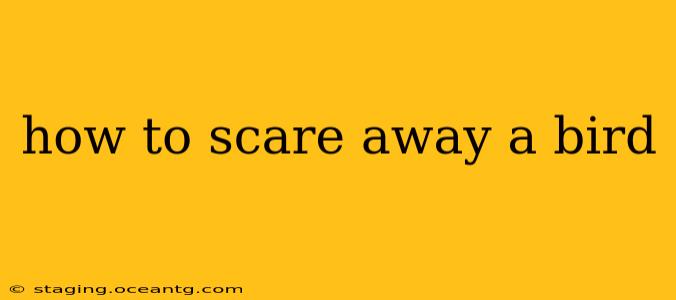Birds can be delightful creatures, but sometimes their presence becomes a nuisance. Whether they're raiding your garden, nesting under your eaves, or leaving droppings on your patio, finding effective and humane ways to deter them is crucial. This guide provides various methods to scare away birds, addressing common concerns and offering solutions for different situations.
Why Are Birds a Problem?
Before diving into solutions, it's important to understand why birds might be causing issues. Understanding the root cause can help you choose the most effective deterrent. Are they attracted to a readily available food source? Is there suitable nesting material nearby? Identifying the reason for their presence is the first step to successful bird deterrence.
What Are Some Humane Ways to Scare Away Birds?
Many effective methods exist that don't harm the birds. The key is to make your property less attractive and more challenging for them to inhabit.
1. Visual Deterrents:
- Shiny Objects: Hanging reflective objects like Mylar tape, aluminum foil streamers, or old CDs can scare birds away with their movement and flashes of light. The unpredictable movement is often enough to disrupt their feeding patterns.
- Predatory Decoys: Placing realistic-looking decoys of owls, hawks, or other birds of prey can deter them. However, birds quickly become accustomed to static decoys, so rotating their position or using moving decoys is more effective.
- Scarecrows: A classic method, but requires regular repositioning to remain effective. Adding movement, like attaching streamers or using a wind-powered mechanism, can significantly improve their efficacy.
2. Auditory Deterrents:
- Ultrasonic Devices: These emit high-frequency sounds inaudible to humans but unpleasant to birds. They're generally considered humane, but their effectiveness can vary, and some birds may become accustomed to them over time.
- Noisemakers: Sudden loud noises, such as banging pots and pans or using noisemakers, can startle birds. However, this method is temporary and requires consistent repetition.
3. Physical Barriers:
- Bird Netting: This is particularly effective for protecting fruit trees or other vulnerable plants. Ensure the netting is appropriately sized and installed to avoid harming birds.
- Spikes: These deter birds from landing on ledges, window sills, or other surfaces. However, choose humane spikes that don't injure the birds.
- Exclusion: Modifying your environment to prevent access is often the most effective long-term solution. This could involve sealing gaps in your roof, installing screens over vents, or using netting to cover vulnerable areas.
What Sounds Scare Birds Away?
Birds are sensitive to a range of sounds. While loud, sudden noises can startle them temporarily, the most effective sounds are those that mimic the calls of their natural predators or unsettling high-pitched noises. Ultrasonic devices aim to replicate these unsettling sounds.
How Do I Keep Birds From Nesting Under My Eaves?
Preventing nesting is best achieved through physical barriers. Seal any gaps or openings under your eaves where birds might gain access. Installing netting or bird spikes can prevent them from building nests.
What's the Best Way to Deter Birds From My Garden?
A multi-pronged approach often works best. Combine visual deterrents like shiny objects or predatory decoys with physical barriers like netting over vulnerable plants. Removing readily available food sources and water sources will also help.
Are There Any Natural Ways to Scare Away Birds?
Several natural methods exist, including planting bird-repellent plants (certain strong-smelling herbs might deter some birds), using predator scents (like coyote urine), or creating a less attractive environment. The effectiveness of these methods can be variable.
Conclusion: Finding the Right Balance
Choosing the right bird deterrent depends on the specific situation and your personal preferences. Always prioritize humane methods that don't harm the birds. A combination of strategies is often the most effective approach. Remember to be patient and persistent; it might take time to find the most effective solution for your specific situation.
